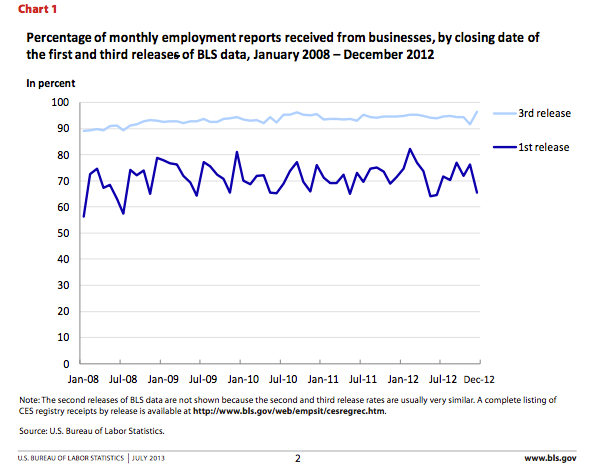China and Nepal used to disagree about the height of Mount Everest. Nepal counted the snow caps while China just included the rock height. Consequently, Nepal said the peak was 4 meters higher than China. Then, in 2010, China said okay, the official height of Mount Everest, at 8,848 meters (29,028.9 feet), will include the snow but we won’t ignore the 8,844 meter rock height. I should add that the mountain is probably higher now because shifting continental plates are easing India under China and Nepal.
Where are we going with this? There is lots more to a statistic than one number.
In the April 2012 jobs report, the Bureau of Labor Statistics (BLS) reported that 115,000 jobs had been added to the labor force. Later though, they said job creation was really 68,000. In November the 146,000 new jobs number was subsequently changed to 247,000.
In this BLS table, you can see how the numbers were revised during 2012:

What is going on?
On the first Friday of most months we get the jobs data. While the percent unemployed comes from a household survey, the jobs added or lost come from approximately 560,000 “worksites” that are typically called businesses. The problem is that when reporting time comes, not all “businesses” are ready. Still though, even when 73.1% report–the 2012 initial monthly average–BLS statisticians assume 100% had similar numbers.
You see where this is taking us. As the month unfolds, more businesses submit their payroll numbers. Finally by the third revision, as during 2012, BLS has heard from 94.6% of all businesses in their sample.. But because they assumed the same trends for everyone, any deviations make a revision necessary.
Percent of businesses that submit monthly employment reports:

So, hearing that May 2014 nonfarm employment was up by 217,000 jobs, we can assume by next month that the 217,000 will rIse if the late reporters had many more jobs than what was already recorded and it will fall if the opposite was true.
And that is why, at the bottom of yesterday’s report, they noted that, “After revision, the change in total nonfarm employment for March remained +203,000, and the change for April was revised from +288,000 to +282,000. With these revisions, employment gains in March and April were 6,000 lower than previously reported.”
Our bottom line? We asked, “How wrong are BLS jobs numbers?” The answer? I am not sure. In addition to the size of the sample, as with measuring Mount Everest, we have other variables that can be interpreted differently.
Please let us know what you think the answer is in a comment.
How Wrong Are BLS Jobs Numbers?

Elaine Schwartz
Elaine Schwartz has spent her career sharing the interesting side of economics. At the Kent Place School in Summit New Jersey, she was honored with an Endowed Chair in Economics. Just published, her newest book, Degree in a Book: Economics (Arcturus 2023), gives readers a lighthearted look at what definitely is not “the dismal science.” She has also written and updated Econ 101 ½ (Avon Books/Harper Collins 1995) and Economics: Our American Economy (Addison Wesley 1994). In addition, Elaine has articles in the Encyclopedia of New Jersey (Rutgers University Press) and was a featured teacher in the Annenberg/CPB video project “The Economics Classroom.” Beyond the classroom, she has presented Econ 101 ½ talks and led workshops for the Foundation for Teaching Economics, the National Council on Economic Education and for the Concord Coalition. Online for more than a decade. econlife has had one million+ visits.





